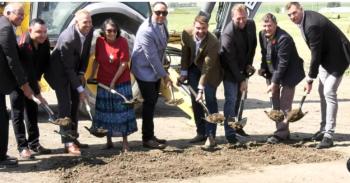Image Caption
Summary
Local Journalism Initiative Reporter
Windspeaker.com
Shovels were dug into the ground this morning by the Blood Tribe to mark the start of construction of the first of four recovery communities announced for First Nations in Alberta.
“There’s been a long and hard battle for our people,” said Blood Tribe Councillor Piinaakoyim Tailfeathers.
Ten years ago, the southern Alberta First Nation declared a local state of emergency because of the sudden increase in deaths due to opioid poisoning.
Now, with support from the provincial government of $30 million to cover capital costs and a commitment for operating dollars, construction will begin on the 75-bed facility to be located in the Moses Lake community. The facility is slated to open by the end of 2024.
The official announcement for the facility was made three years ago, but forward progress was delayed in large part due to COVID-19 complications.
“This expansion of our services is much needed, a key component in healing and providing another level of care. We hope to see members leave this facility ready to live meaningful lives and gain employment and join their families again,” said Tailfeathers.
He added that drug abuse was a symptom of much larger issues and those root causes, such as poverty, inequality and trauma, needed to be addressed.
The Blood Tribe Department of Health is working with the provincial government on a flexible model of treatment that will combine Blackfoot ways of healing with a western approach, said Charles Weasel Head, vice chair with the Blood Tribe Department of Health and former Blood Tribe chief.
“We've always exercised our traditions along with our Elders’ participation and our family unit to come together, and that's what we're doing presently and currently right now,” said Weasel Head.
The Blackfoot way is to care for the whole self, he said, emotionally, mentally, physically, and spiritually.
“We really respect the whole notion about a recovery model because it aligns with who we are. We believe that family and community, all of our people, have to be involved in this holistic way of treating our people through this addiction,” said Weasel Head.
The recovery-oriented system and involuntary treatment have been bedrocks of the United Conservative Party (UCP) government’s approach to dealing with addictions issues.
Indigenous communities have been disproportionately hit by the addictions crisis, said Mental Health and Addictions Minister Dan Williams, who was joined by a handful of other ministers at the site of the groundbreaking.
“We've made significant strides in responding to this crisis, but we know more needs to be done when it comes to community and recovering. Access to land based, culturally integrated addiction treatment services is often limited or missing completely,” he said.
Williams added that the province was filling the gap left behind by federal government inaction and partnering with First Nation communities to establish holistic addiction treatment facilities on First Nations nation lands.
The Blood Tribe Recovery Community will be a uniquely designed building that can accommodate cultural healing and ceremonies, including smudging, dancing and drumming. The location will also be able to host community gatherings.
Treatment at the recovery centre, which will be operated by the Blood Tribe Department of Health, will be open to both Indigenous and non-Indigenous people. When the facility ramps up, it will service 300 people, who will be allowed to stay up to one full year.
Recovery communities have also been announced for Tsuut’ina, Siksika and Enoch Cree Nations. Each First Nation will receive $30 million for capital costs for 75-bed facilities to serve 300 people. No dates as to groundbreaking or construction completion for those three facilities have been announced.
Alberta will be establishing 11 recovery communities. The first facility recently opened in Red Deer.
Williams, who has yet to receive his mandate letter from Premier Danielle Smith, said he was anticipating direction on the Compassionate Care Intervention Recovery Act, which in part, will legislate for involuntary treatment, which would force people with severe drug addictions into treatment.
Local Journalism Initiative Reporters are supported by a financial contribution made by the Government of Canada.

